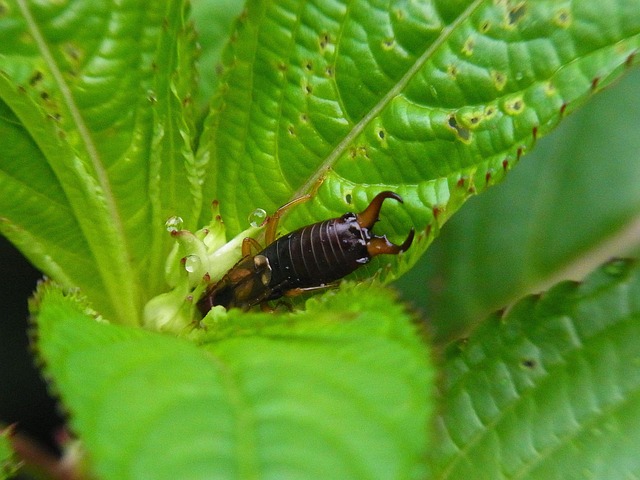Identify early signs of an earwig infestation—holes in plants, chewing damage, and musty odors—and take action with natural, non-toxic methods. Prevent earwigs by maintaining a clean home, sealing gaps, using herbal repellents, and introducing beneficial insects. Eradicate them with essential oils or boric acid, but use these methods cautiously around children and pets. Implement long-term strategies like sealing entry points, cleaning regularly, and trimming garden plants to avoid future infestations. Opt for eco-friendly earwig solutions for a healthier, pest-free environment.
“Uncover the subtle signs of an earwig infestation and take back control of your space. This comprehensive guide equips you with the knowledge to recognize these elusive pests and implement effective, eco-friendly solutions. From identifying telltale signs like peculiar damage or live insects to exploring natural prevention methods and home remedies, we offer a step-by-step approach to eradication. Learn long-term management strategies to prevent future invasions and discover the best eco-friendly earwig solutions for a pest-free environment.”
Recognizing Earwig Infestation: Signs to Watch Out For
Recognizing an earwig infestation early on is crucial for effectively addressing the issue. One of the first signs to watch out for is the presence of small, oval-shaped holes in plant leaves and flowers. Earwigs are known for their penchant for chewing on plants, especially during the night, leaving behind distinctive damage. Another telltale sign is the sight of these insects themselves—long, slim bodies with a pair of cerci (tail-like appendages) that look like tiny hooks. You might spot them scurrying along walls, under furniture, or even in potted plants.
Additionally, earwigs are attracted to moisture and dark spaces. Look for signs of their presence near water sources, such as leaks or high humidity areas. They tend to nest in tight crevices and voids, including cracks in walls, around doors, and within electrical boxes. If you notice a persistent musty odor or see small brown droppings (similar to feces) in affected areas, it could indicate an earwig infestation. These eco-friendly earwig solutions can help manage the situation without resorting to harsh chemicals.
Eco-Friendly Prevention and Control Methods
Preventing and controlling earwigs naturally is a preferred option for many due to its minimal environmental impact. One effective method is to maintain a clean and sealed home. Earwigs are attracted to moisture and organic debris, so regularly cleaning your space, especially in areas like bathrooms, kitchens, and damp corners, can deter them. Seal any gaps or cracks around windows, doors, and pipes with caulk to prevent their entry. Natural repellents like mint, lavender, citronella, or neem oil are also excellent eco-friendly options. Planting these herbs around your home’s perimeter or using them in homemade sprays can act as a psychological barrier against earwigs without harming them or the environment.
Another strategy involves introducing beneficial insects that feed on earwigs, such as certain species of wasps or ladybugs. This biological control method is safe and sustainable, ensuring that earwig populations are reduced naturally. Additionally, using pheromone traps can help monitor and control their presence effectively without resorting to harsh chemicals. These eco-friendly solutions offer a humane and non-toxic approach to managing earwig infestations while promoting a healthier ecosystem.
Home Remedies for Earwig Eradication
Earwigs can be a persistent pest, but there are several eco-friendly earwig solutions that can help eradicate them naturally. One effective home remedy involves using essential oils like peppermint, lemon, or lavender. These powerful scents repel earwigs and can be applied to cracks, crevices, and entry points around your home. A simple mixture of 10 parts water to 1 part oil in a spray bottle is all you need to create a potent insecticidal spray that won’t harm the environment or other beneficial insects.
Another organic method involves using boric acid or diatomaceous earth. These natural powders can be sprinkled in areas where earwigs are suspected to hide, such as under sinks, in cupboards, and around windowsills. The powder acts as a desiccant, drying out the earwigs and causing them to die from dehydration. Be sure to apply these substances with caution, keeping them out of reach of children and pets, and always follow safety instructions on the packaging for best results when using eco-friendly earwig solutions.
Long-Term Management Strategies for Future Infestations
To prevent future earwig infestations, adopt long-term management strategies that focus on exclusion and environmental modification. Seal any gaps or cracks in walls, doors, and windows with caulk or weatherstripping to deny entry points. Regularly inspect and clean your home, removing potential hiding spots like piles of newspapers, cardboard boxes, or plant debris. Maintain a tidy garden, trimming bushes and trees to reduce shadowed areas where earwigs thrive.
Consider implementing eco-friendly earwig solutions like introducing beneficial insects such as spider mites or ladybugs that feed on earwigs. Planting mint, basil, lavender, or marigolds around your property can also act as natural repellents due to their strong scents that earwigs find unpleasant. Regularly vacuuming and properly disposing of waste will reduce earwig attractions, promoting a pest-free environment in the long term.
In conclusion, an earwig infestation can be a pesky problem, but with the right knowledge and approach, it’s manageable. By recognizing the signs early on, employing eco-friendly prevention methods, trying home remedies, or adopting long-term management strategies, you can effectively address and prevent future earwig intrusions. Remember, when dealing with pest control, choosing eco-friendly solutions is key to maintaining a healthy environment for both your home and local ecosystem.
